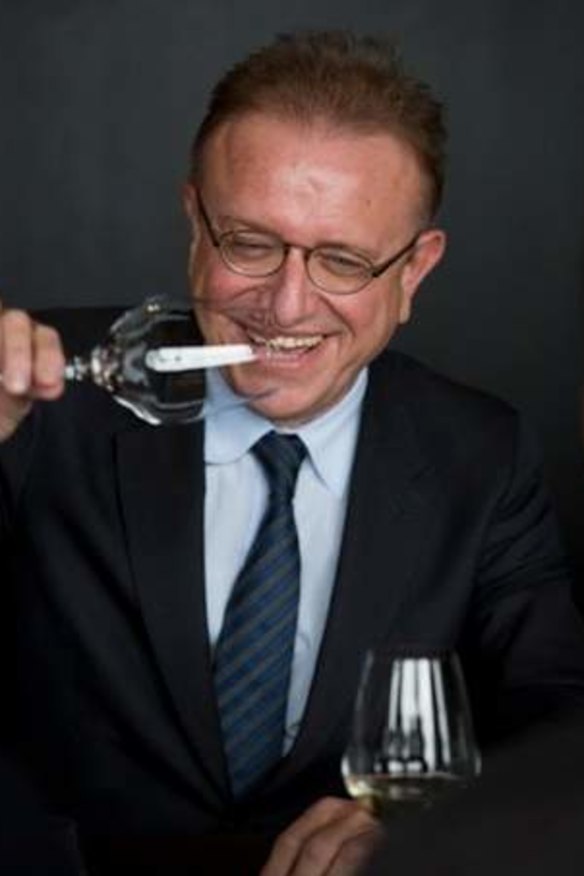Same class, different glass
Releasing the 2004 Dom Perignon, the winemaker tells <b>Jeni Port</b> why champagne shouldn't be drunk in flutes.

Richard Geoffroy, the man behind Dom Perignon, is nicknamed ''the monk''. Responsible for making Dom Perignon for the past 23 years, Geoffroy has taken on the habits (so to speak) of the great Benedictine monk, Brother Pierre Perignon, who toiled so obsessively to establish the reputation of the great champagne in the 1670s.
Dom Perignon was a master blender and was said to have had almost superhuman olfactory abilities - or at least that's the story handed down with three centuries of public-relations licence.
Geoffroy also has a fantastic nose, very Gallic and astute, but importantly he has a photographic memory.
He never makes a note while tasting, re-tasting and re-re-tasting 100 base wines of pinot noir and chardonnay to drill down to the core of 30 to 50 wines that form the basis of each vintage release of Dom. He says he doesn't need tasting notes to keep tabs on individual wines, arguing that words don't come close to describing his feelings.
''A word is already a translation of something, so you have already lost the process,'' he says cryptically. ''It's better to have it totally mental. It's the way I work. Many winemakers see wine as two dimensional, I see it as three dimensional.''
Past memories of every vintage he has been made are securely embedded behind his forehead, and when called on information is ''unloaded''. You'd have to say this is not your usual, garden variety winemaker, even for France.
Geoffroy's degree was in medicine before he turned to winemaking. He says he should have been an architect. At 59, he is the face of Dom Perignon and travels the world working with superstar chefs and artists - he recently collaborated with American artist Jeffrey Koons to design a limited-release bottle of Dom Perignon '03, raising the wine's already high-end profile to something nearing a French national hero. It's a feat of salesmanship, not that he admits to being a seller of anything. That would be declasse.
Geoffroy visited Melbourne recently to promote the new-release 2004 Dom Perignon, with a dinner at Vue de Monde. He recalls the vintage as relatively easygoing compared with the previous year. The heat of 2003 was problematic, so much so that there was some surprise when Dom declared the vintage worthy of a release.
Dom is only made as a vintage champagne, and a list of the last decade of Dom Perignon shows holes where 2001, 1997 and 1994 just weren't judged good enough for a release.
The 2003 harvest proved very ripe, producing a fuller version of Dom, and to some, it's a little forward. It is far from my favourite Dom and very far from the sublime 2002. The 2004 sees a return to a finer, more graceful expression of Dom with a youthful raciness that drives the wine through the mouth and layers of flavour. It's a stunning achievement for a 10-year-old.
''The beauty of '04 is that it was naturally coherent,'' Geoffroy says. ''In '03 I had to work harder, you understand, voila, whereas you know '04 was a case of stepping back.''
Geoffroy says he's seeing the effects of climate change in Champagne, and expects more warm vintages like 2003. He intends not to fight them. ''When you are that marginal in climate to the growing of grapes, you know, the warming tends to be tolerable even positive,'' he says. ''If I am offered a greater potential for ripeness I'm just going for it instead of being really uptight and trying to restrain the whole thing. I'm not afraid of ripeness.''
Riper fruit generally translates into lower acidity, which affects a champagne's structure and ageing potential. Under-ripeness has the opposite effect. Still, with a vintage wine we want the vintage to show through.
If Geoffroy is relaxed about climate change, he is far from cruisy when it comes to the traditional flute-shaped glass for champagne. He detests it. I don't think I have overstated it. For the launch of '04 Dom he requested a wide-mouthed, big bowled Burgundy-style glass. The lively mousse of '04, so energetic and straight, died quickly, but still he insists champagne isn't just about the bubble. He argues if it's to be taken seriously, it has to be put in a serious wine glass.
To Geoffroy, we taste what we see.
''If you see a wine in a narrow glass it will taste narrow,'' he says.
But in a wide Burgundy glass it also risks losing a pulse, and a chat with sommeliers would suggest the Riedel chianti glass is a good bet.
>> Jeni Port is a Melbourne-based wine writer.